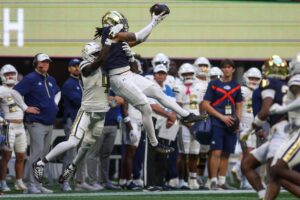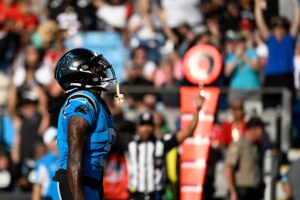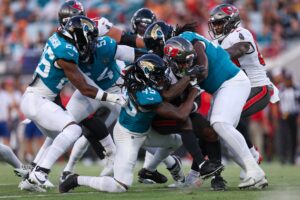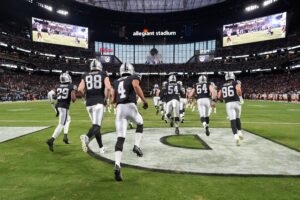The 2018 NFL Draft is officially over, and every team in the league has to feel good about their selections. However, how did each team do with respect to the rest of the league? This installment of the 2018 NFL Draft Grades features an in-depth breakdown of every team in the AFC North and AFC South.
AFC North and AFC South 2018 NFL Draft Grades
Baltimore Ravens: A
Players Added: Hayden Hurst, Lamar Jackson, Orlando Brown, Mark Andrews, Anthony Averett, Kenny Young, Jaleel Scott, Jordan Lasley, DeShon Elliott, Greg Senat, Bradley Bozeman, Zach Sieler
Baltimore’s draft was the envy of many around the league, as the organization added an astonishing twelve players over the course of the NFL Draft, including two first rounders. The 2017 Ravens finished their season 9-7, narrowly missing a playoff berth, so it’s not like this team didn’t have the talent to begin with.
The biggest problem for the Ravens last season was the lack of offense, and general manager Ozzie Newsome knew it. Eight of their twelve picks were spent on the offensive side of the ball, and it’s hard to find a poor choice among them.
Baltimore hasn’t gotten any production out of their tight end position since the days of Dennis Pitta, but that looks to change with the selections of Hayden Hurst and Mark Andrews. Hurst was the best all-around tight end in the draft and can do a little bit of everything. Andrews struggles as a run blocker but should make a great red zone target.
Their biggest steal of the draft came with the selection of Orlando Brown in the third round. Brown was seen as a borderline first-round talent before a horrible combine performance caused his draft stock to plummet. His game tape shows an NFL starter, and film is typically more important than combine performances. He should immediately contribute on the Ravens offensive line.
However, the one pick that could make or break this draft is quarterback Lamar Jackson. After a series of down seasons, it looks like Baltimore is planning for life without Joe Flacco. He’ll need a year or two to develop, but he has the making of a franchise quarterback.
Cincinnati Bengals: B+
Players Added: Billy Price, Jessie Bates, Sam Hubbard, Malik Jefferson, Mark Walton, Davontae Harris, Andrew Brown, Darius Phillips, Logan Woodside
Another team with several draft needs, the Cincinnati Bengals did a solid job filling that talent via the draft. Everyone and their mother knew the Bengals needed help along the interior offensive line, so the selection of Billy Price makes perfect sense. Price was something of a reach, as there were several objectively better players available at 22. However, Price was still protected as a late first-early second, and he fills the Bengals biggest need.
Sam Hubbard instantly fits the team as a situational pass rusher. Hubbard was projected as a late first, early second selection, so drafting him in the third round was a great move. He may not be an immediate starter, but he should contribute immediately on passing downs.
While the Bengals added several key players to positions of need, they completely ignored the wide receiver position. Quarterback Andy Dalton isn’t good enough to do it alone, and right now he doesn’t have much help. A.J. Green is still amazing, but the options behind him are either injury prone or underwhelming. Cincinnati is making a major bet on 2017 first-round selection John Ross bouncing back from a rough rookie season.
Cleveland Browns: B
Players Added: Baker Mayfield, Denzel Ward, Austin Corbett, Nick Chubb, Chad Thomas, Antonio Callaway, Genard Avery, Damion Ratley, Simeon Thomas
The Cleveland Browns entered the 2018 NFL Draft with a plethora of draft picks. Cleveland led off the draft by finally selecting a quarterback first overall. After watching Carson Wentz and Deshaun Watson pass them by in consecutive years, Cleveland pulled the trigger on Oklahoma quarterback Baker Mayfield.
It’s anyone’s guess if Mayfield (or anybody, for that matter) can finally be the franchise savior Cleveland needs, but he has all the tools to make it work. He’ll have time to learn behind Tyrod Taylor before inevitably taking over the starting job. For the first time in a long time, the Browns have genuine hope under center.
Denzel Ward pick was a poor decision, considering the talent they could have acquired. While Ward will be a good player, Bradley Chubb will be a great player. Chubb was the best defensive player in the draft and was still available at the number four selection. However, the Browns overthought it and selected an inferior player because the need for a cornerback was greater than the need for a pass rusher.
Outside of selecting Ward over Chubb, Cleveland didn’t make their typical head-scratching decisions. They didn’t reach for any players, and each member of the draft stands a genuine chance to contribute to the team.
The one area they surprisingly ignored was the left tackle position. Longtime left tackle and future Hall of Famer Joe Thomas hung up the cleats for good, yet the Browns didn’t draft his successor. With a rookie quarterback, the Browns top priority should have been to make Mayfield’s life as easy as possible. The first step to that is giving him protection with a strong left tackle.
Pittsburgh Steelers: A-
Players Added: Terrell Edmunds, James Washington, Mason Rudolph, Chukwuma Okorafor, Marcus Allen, Jaylen Samuels, Joshua Frazier
While the Edmunds selection doesn’t make much sense on the surface, it’s actually a strong selection. The Pittsburgh Steelers needed a linebacker, but opted for Edmunds, since four linebackers had already been selected in the first round.
With teams playing more and more sub-packages, the right type of safety can fill the void as a linebacker. Edmunds is a hard-hitting, physical player who excels against the run. In many ways, he’ll do exactly what’s expected from a linebacker, while also serving as a safety.
James Washington appears to be a reach in the second round if he were selected by any team other than the Steelers. Pittsburgh is the master of developing second- and third-round receivers, so they’ve certainly earned the benefit of the doubt here.
The Pittsburgh Steelers also made the smart move of selecting Ben Roethlisberger’s heir in Oklahoma State quarterback Mason Rudolph. Rudolph was projected as a top-40 pick, so Pittsburgh couldn’t avoid drafting him in the third round. Rudolph can learn behind Big Ben before eventually taking over the top spot.
Perhaps the biggest surprise is that the Steelers waited until the fifth round to draft a running back. They still have Le’Veon Bell, but it’s becoming more and more likely that Bell will depart after 2018. Even if he doesn’t, availability has always been the biggest knock against Bell. Considering how important he is to the Steelers offense, it’s surprising that they didn’t invest higher in a backup plan.
Houston Texans: C-
Players Added: Justin Reid, Martinas Rankin, Jordan Akins, Keke Coutee, Duke Ejiofor, Jordan Thomas, Peter Kalambayi, Jermaine Kelly
The Houston Texans did what they could, but they didn’t have much opportunity to add top talent in this draft. Thanks to the Deshaun Watson trade, Houston’s first pick came in the third round. Obviously, Houston would take that trade every day of the week, but it limited their draft potential in 2018.
That being said, the Justin Reid selection was an absolute home run. Reid is one of the most intelligent players in the draft, playing seven different positions while in college. He’s athletic enough to play a variety of spots at the NFL level and is the definition of versatility. He was expected to be a second-round selection, with some having him go in the first round. Houston must have been thrilled to see him fall to them.
Outside of Reid, the Texans didn’t grab any immediate starters. Most of that was due to their poor draft capital, but Houston made some questionable decisions of their own. Despite their limited number of picks, the Texans selected two tight ends to join their crowded depth chart. While C.J. Fiedorowicz’ retirement means there’s a starting spot up for grabs, Houston had seven tight ends on the roster entering the draft. Nonetheless, Houston selected Jordan Akins and Jordan Thomas, meaning that 10% of the Texans 90-man roster are tight ends.
Indianapolis Colts: B+
Players Added: Quenton Nelson, Darius Leonard, Braden Smith, Kemoko Turay, Tyquan Lewis, Nyheim Hines, Daurice Fountain, Jordan Wilkins, Deon Cain, Matthew Adams, Zaire Franklin
After years of blatantly ignoring the offensive line, the Indianapolis Colts finally invested in protecting Andrew Luck by selecting Quenton Nelson sixth overall. Several analysts had Nelson as the second-best prospect, regardless of position, in the entire draft. Thanks to an early run on quarterbacks, Nelson fell to number six, and the Colts made a great move. The last three seasons show how crucial Luck’s health is, and Nelson should go a long way in keep Luck upright.
The wide receiver class as a whole went lower in the draft than expected, but the selection of wide receiver Deon Cain was still one of the better moves in the draft. Cain is an incredibly shifty receiver with great speed and burst. He should be able to contribute, especially on a receiver depth chart that doesn’t have much outside of T.Y. Hilton. Getting him in the sixth round may have been general manager Chris Ballard’s best move of the day.
The strangest decision of the event was that the Colts opted not to draft a top cornerback, despite having the perfect draft picks to do so. Thanks to a trade with the New York Jets, Indianapolis had four second-round picks. Combine that with the fact that Indianapolis had lost their two best corners in Rashaan Melvin and Vontae Davis, and selecting a cornerback seemed like a no-brainer.
However, the Colts went a different route. They managed to get solid players, but right now, it’s anyone’s guess who lines up in the secondary. The Colts had the 29th ranked defense in football, and ignoring the cornerback position isn’t a good way to improve that standing.
Jacksonville Jaguars: B-
Players Added: Taven Bryan, DJ Chark, Ronnie Harrison, Will Richardson, Tanner Lee, Leon Jacobs, Logan Cooke
The Jacksonville Jaguars boast one of the best rosters in the league and didn’t have many needs entering the draft. Their defense was absolutely dominant in 2017, and the rich got richer with the selection of Taven Bryan. Bryan can line up all along the defensive line and can generate pressure no matter who he goes against. The Jaguars led the league in sacks last season, so their defensive line should be a nightmare for opposing offenses in 2018.
The Jaguars biggest steal of the day came by selecting Ronnie Harrison in the third round. Initially projected as a top-five safety, Harrison’s stock plummeted such that the Jaguars were able to take him with the 93rd overall pick. Jacksonville doesn’t need another safety, put Harrison’s talent was just too good to pass up at 93.
Why the Jaguars only took one receiver is anyone’s guess. DJ Chark should be a good receiver in this league for years to come, but Jacksonville needs more than just him. After watching Allen Robinson and Allen Hurns depart in free agency, the Jaguars certainly need some receiver help. They added Donte Moncrief in free agency, but he’s nothing more than a role player.
Blake Bortles is not the type of quarterback capable of lifting up the talent around him. He’s very much the product of his environment, and he needs all the help he can get. Jacksonville wasn’t in the position to draft his replacement, but they didn’t do much to help him out. Poor offense cost them a trip to the Super Bowl, and unless Bortles grows in year five, it could cost them again.
Tennessee Titans: B
Players Added: Rashaan Evans, Harold Landry, Dane Cruikshank, Luke Falk
The Tennessee Titans only added four players, but the first two are complete difference makers. Trading up to grab Rashaan Evans was a great move, as Tennessee needed major help as the linebacker position. Outside of an aging Wesley Woodyard, the Titans didn’t have any concrete plans at linebacker. Thanks to the Evans selection, they now have a linebacker capable of doing everything. With him lined up as the outside linebacker, this stout Titans defense gets even better.
Harold Landry is one of the biggest boom or bust picks in the draft, and it all comes down to his health. Based on talent alone, Landry was one of the top 15 or so players in the draft. However, injury concerns regarding his knee and back caused him to fall all the way to the 41st pick. These health injuries were so worrisome that some teams took him off their board altogether.
If Landry stays healthy, he’s one of the best difference makers in the draft. However, that’s a big if. The Titans clearly felt good enough about his health to trade up for the guy, so take that for what it’s worth. However, only time will tell if this was the right move to make.
After Landry, the Titans had to wait until the fifth round to make another selection. It’s understandable why they traded up to draft the players they did, but they sacrificed a lot of depth to do it. In a league where injuries are so commonplace, having guys that can come off the bench and play is paramount to sustained success. Should injuries strike, the lack of mid-round pick may come back to bite the Titans in 2018.
Main photo:
Embed from Getty Images






